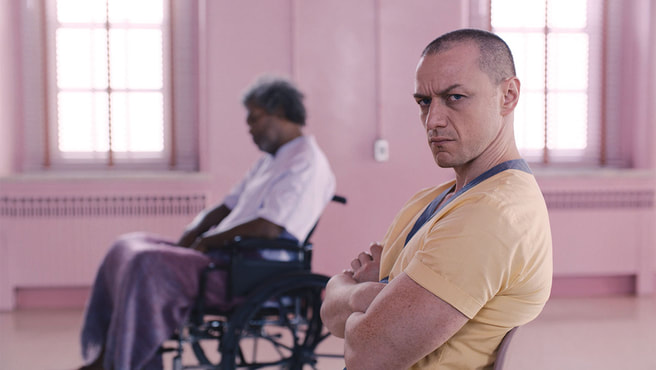GLASS
***
Director: M. Night Shyamalan
Screenwriter: M. Night Shyamalan
Principal cast:
Bruce Willis
Samuel L. Jackson
James McAvoy
Sarah Paulson
Anya Taylor-Joy
Spencer Treat Clark
Charlayne Woodard
Country: USA
Classification: M
Runtime: 129 mins.
Australian release date: 17 January 2019
Previewed at: Hoyts Broadway, Sydney, on 17 January 2019.
Director/writer M. Night Shyamalan is probably best remembered for his 1999 film Sixth Sense, but his new movie Glass combines characters and story elements from two other titles in his back catalogue, 2000’s Unbreakable and 2016’s Split. From Unbreakable, David Dunn, the vigilante super-hero now known on the net as ‘The Overseer’ (Bruce Willis), and Elijah Price, the brilliant but crazed comic book collector with the nickname Mr. Glass (Samuel L. Jackson), return for an encounter with Split’s Kevin Wendell Crumb (James McAvoy), the multi-personality zoo worker who is host to a serial killer called ‘The Beast’, who seems to possess superhuman powers. Also back from Split is Casey Cooke (Anya Taylor-Joy), the only victim of ‘The Beast’ to survive an encounter with him, and from Unbreakable, Spencer Treat Clark as Dunn’s son Joseph and Charlayne Woodard as Mr. Glass’s devoted mum. It’s necessary to point these connections out so that would-be viewers understand that, to get the most out of Glass, it’s best if you’ve seen the earlier two movies - not essential but best.
The latest film picks up in Philadelphia a few weeks after the conclusion of Split and sees Dunn father and son in pursuit of ‘The Beast’, who’s captured four cheerleaders and is holding them captive in a disused warehouse. Tracking him down, though, brings both ‘The Overseer’ and Crumb’s deadly alter-ego into contact with Dr. Ellie Staple (Sarah Paulson), a mysterious psychiatrist who presides over their capture and subsequent incarceration in the Raven Hill Memorial Psychiatric Hospital. Lo and behold! Who else should be imprisoned there but Elijah, seemingly kept in a permanent state of semi-consciousness, manacled by ‘chemical handcuffs’. Dr. Staple is intent on convincing the trio that they do not really have any actual superhuman abilities but are, in fact, suffering from delusions of grandeur that can be explained by other means. During these psychoanalytical sessions, it becomes evident that someone is being ‘played’, but just who is playing who isn’t clear until Glass’s denouement.
This intriguing culmination of Shyamalan’s trilogy is co-produced by Blumhouse Production’s Jason Blum, who also produced the writer/director’s previous two films, Split and The Visit. Blum, of course, is the highly successful producer of the Paranormal Activity and Insidious franchises, along with stand-alone titles like Get Out, Upgrade and many others. He’s kind of like a modern-day Roger Corman, specialising in movies with a budget of US$3,000,000 or less. He has said, “his formula for making movies as inexpensively as possible does not mean looking for low-budget movies to see if he likes them, but looking for movies he likes, and then seeing if they can be done on a low budget.” Certainly, Glass would have cost a lot more than that but at least it sticks to one part of his formula by not having many locations - it’s largely filmed indoors with only a few Philadelphia external shots. Samuel L. Jackson is always great to watch, even when semi-comatose much of the time, and McAvoy is simply remarkable as he morphs from personality to personality (Kevin has 23 of them), often in the blink of an eye. Willis plays his role in a fairly dead-pan manner, indeed, he’s too laidback. You’d expect that Dunn would have been more expressive, given what he’s up against. A high-point of the technical credits is the impressive sound design; it adds a real sense of menace and creepiness to Shyamalan’s story. On that note, the script earns credit for inventiveness (he’s always original) but it stretches the bounds of credulity too often to be entirely effective. Regrettably, although it features the director’s trademark shifts and twists, Glass ends up belonging more in the Marvel or DC Comic universes than in the real world.
